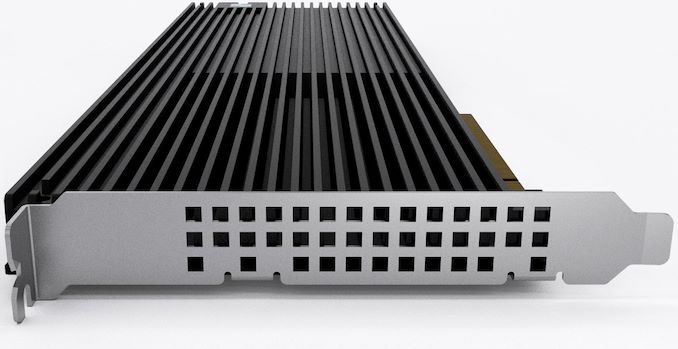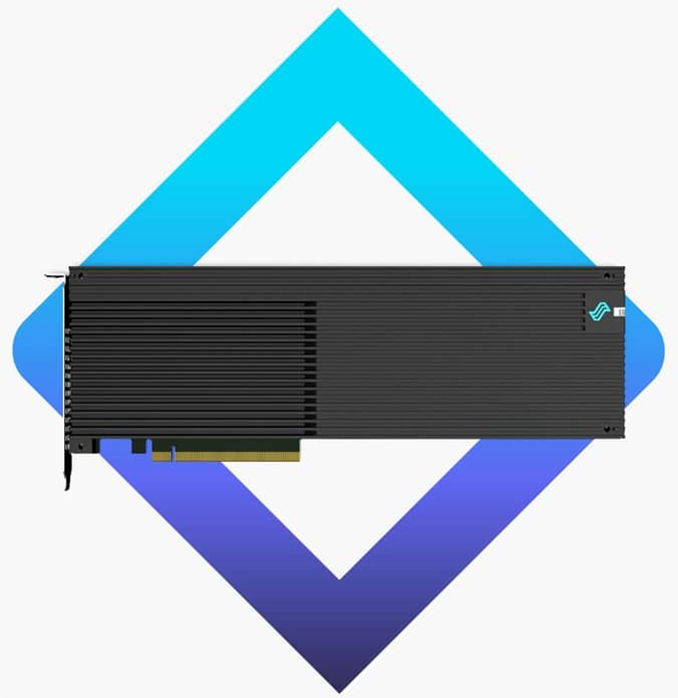Liqid to Demonstrate Element LQD4500 PCIe 4.0 x16 SSD: 32 TB At Up to 24 GB/s
by Anton Shilov on August 2, 2019 11:00 AM EST- Posted in
- SSDs
- Storage
- Phison
- Enterprise SSDs
- PS5016-E16
- Liqid
- FMS 2019

Liqid, a maker of SSDs for mission critical and performance-hungry applications, plans to demonstrate one of the world’s first PCIe 4.0 x16 solid-state drives at Flash Memory Summit next week. The Element LQD4500 SSD is designed to offer superior sequential and random performance along with an enterprise-grade feature set and reliability. Making this all the more noteworthy is that the drive is based on consumer-grade components.
The Liqid Element LQD4500 SSD is based on multiple Phison PS5016-E16 controllers (with a PCIe 4.0 x4 interface) featuring a custom firmware and carries up to 32 TB of raw 3D TLC NAND flash. Liqid is presumably doing on-card NVMe RAID here, similar to what we've seen in some PCIe 3.0 x16 cards in the last couple of years. Being aimed at datacenters or enterprises, the Element LQD4500 supports power loss data protection and features numerous proprietary technologies from Liqid, including active telemetry monitoring, advanced error recovery, and active thermal throttling.
The fastest Liqid Element LQD4500 SSDs will offer up to 24 GB/s sequential read and write speeds as well as up to 4 million read and write IOPS (sustained random writes are rated at 600K IOPS). Such drives will also offer an ~80 μs read access latency as well as a ~20 μs write latency.
The drive comes in a full-height full-length (FHFL) add-in-card (AIC) form-factor with a one-wide passive cooling system, and is therefore compatible with large systems that need extreme performance and can provide a minimum of 400 LFM of air flow, as the card consumes and dissipates up to 65 W of power. Depending on customer requirements, the drive can be configured for different capacities, performance, and endurance levels.
| General Specifications of the Liqid Element LQD4500 SSD | ||
| Data Center Drives | Enterprise Drives | |
| SKUs | 7.68 TB: LQD-E2DPNBD08M007T68 15.36 TB: LQD-E2DPNBD08M015T36 30.72 TB: LQD-E2DPNBD08M030T72 |
6.40 TB: LQD-E2DPNBD08M006T40 12.80 TB: LQD-E2DPNBD08M012T80 25.60 TB: LQD-E2DPNBD08M025T60 |
| Controller | 8x Phison PS5016-E16 | |
| NAND Flash | 3D TLC NAND | |
| Form-Factor, Interface | Full-height full-length (FHFL) add-in-card (AIC) PCIe 4.0 x16, NVMe 1.3 |
|
| Sequential Read | up to 24 GB/s | |
| Sequential Write | up to 24 GB/s | |
| Random Read IOPS | up to 4M IOPS | |
| Random Write IOPS | up to 4M IOPS | |
| Sustained Random Write IOPS | 600K IOPS | |
| Pseudo-SLC Caching | ? | |
| DRAM Buffer | Yes, capacity unknown | |
| AES Data Encryption | Yes | |
| Power Consumption | up to 65 W | |
| Warranty | 3 years | |
| Compatibility | Windows, Windows Server 2012, 2012 R2 RHEL; SLES; CentOS, Solaris, SUSE, VMware | |
| TBW | up to 61.53 PBW | |
| Additional Information | Link | |
| MSRP | ? | ? |
The Liqid Element LQD4500 SSD will be demonstrated at FMS by Phison, which happens to be an investor of Liqid. There is no word regarding availability or pricing of these drives, but given their performance and capabilities, we're not expecting this card to come cheap.
Related Reading:
- Phison’s PS5016-E16 & PS5019-E19: The First PCIe 4.0 Client SSD Controllers
- Memblaze Launches PBlaze5 SSDs: Enterprise 3D TLC, Up to 6 GB/s, 1M IOPS, 11 TB
- Samsung 30.72 TB SSDs: Mass Production of PM1643 Begins
- Intel QLC NAND Updates: Up to 20TB In 2.5-inch SSD
- Unlimited 5 Year Endurance: The 100TB SSD from Nimbus Data
Sources: Liqid, Phison












23 Comments
View All Comments
mdrejhon - Friday, August 2, 2019 - link
Great scott! Who needs such nuclear bandwidth? That thing must be flux capacitor powered!I'll take it.
FunBunny2 - Sunday, August 4, 2019 - link
"If you're reading a multiple of a flash page at a time, then you can get random bandwidth to match sequential. Under the hood, decent SSDs actually round robin sequential reads across all of the underlying hardware, so they can run as fast as whatever their bottleneck resource is. The bottleneck could be error correction, the SATA link, or the channels (copper traces) between the NAND and the controller, for example. Random reads with enough parallelism give the SSD enough scheduling freedom to have the same throughput as sequential."-- russell_sears
here: https://news.ycombinator.com/item?id=12162665
FastCarsLike - Sunday, May 31, 2020 - link
This is already outdated folks, PS5 has the "fastest drive in the world". Get gud liqid!